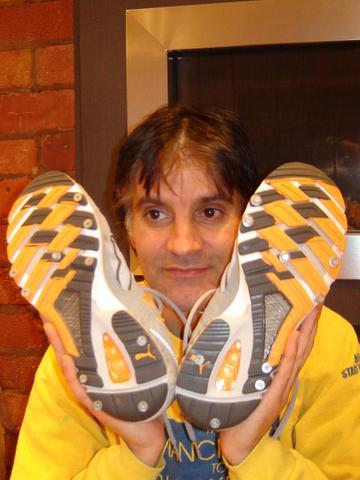Get a grip!

How are things under-foot in your part of the country? After around six inches of snow fell about ten days ago, we still have plenty around as well as many icy stretches where running needs great care and attention!
Last Sunday I ran with two training partners and two dogs and it was great fun, although slow going, and my legs and feet were freezing at times! We found ourselves ploughing through drifts that were thigh-deep and came across styals and kissing-gates that were almost completely buried. This was in the Peak District, by the way. The views were stunning - proper Christmas Card stuff! Today the views were just as stunning but with no fresh snow and the stuff that is lying there very icy, there were parts that were treacherous. I was wishing I had thought about it and gone for my screw shoes!
Footwear
When the worst of the weather hit us a couple of years ago many runners resorted to the treadmill or to cross training activities to keep their aerobic fitness up but running across a beautiful, snowy landscape is incredibly invigorating and, if you feel secure, can be more enjoyable than running in any other conditions. We are lucky to live on the edge of the Peak District and have a great group of friends that also enjoy getting out on the hills and fells in all weather to enjoy the weather and the scenery.
So - if you are suitably inspired, but are concerned about the slippage factor, here is how you can make yourself safe if you have an old pair of running shoes that you are happy to convert for the purpose of snow running.
In a pair of screw shoes you will be able to tackle the hard packed snow and ice. The only time you do need to be careful is on shallow ice where the screws may hit the pavement and, even then, you will probably be better off than in pair of unscrewed shoes! In fact, you don't need to only keep them for wintry conditions as they are also good on soft trails. You may notice the occasionally click-clack sound on harder parts of ground but they will grip on loose and wet surfaces better than a road shoe.
Matt Carpenter says that he uses 18 screws in his shoe and his wife has 19 but I have a pair with just 10 (one has fallen out of the left shoe) placed around the forefoot area and a smattering around the heel for those down hill sections.
Injury warning
Having raged about the joy of running in the snow, it would be remiss not to warn about the increased chance of injury from running in such conditions. Running on snow and ice changes the way you run and also the load that goes through your body. Grippy footwear keeps you safe from slipping but it tends to be less cushioned than a road shoe and so, if you are running on ice, your body is receiving impact from the harder surface and the shoe. Your body also has to work harder to keep you stable.
There is less impact with softer snow but you have to work so much harder to push off and pick your knees up. Last week it took us around 70% longer to do our 10 mile run and it left me still tired for my session the next day (tired hips and thighs as well as lower legs). I probably should have had a day off on Monday or just a very easy run. When running in snow, it is probably wise to run for time rather than distance (although we actually wanted to stay out longer because it was such a beautiful day in such a wonderful environment) and leave extra recovery after the snow and ice sessions. We always advise that, when changing your training or adding anything new, you do it gradually to allow your body time to adapt. Let's face it, running in snow and ice is a change and so too much at once would be risky.
I'm not sure how much longer the snow will be here but it's great to enjoy it while we can. The key is to be prepared with the right equipment and plan and to recover adequately afterwards. Have fun out there!
